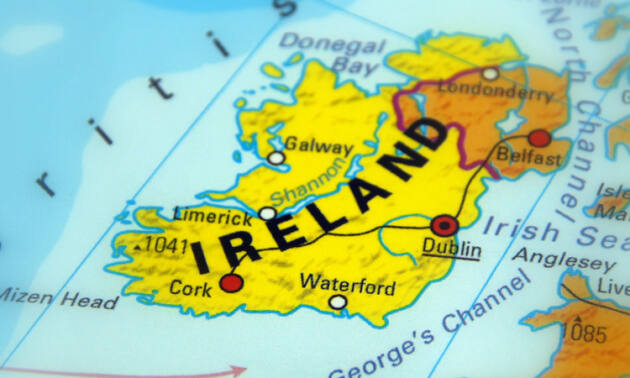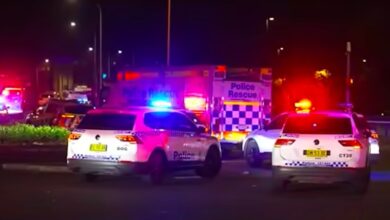A century after partition and civil war, Ireland’s churches are cooperating
Leaders from Ireland’s main Christian traditions held a “Service of Reflection and Hope” in Armagh, Northern Ireland on Oct. 21, 2021, marking 100 years since “the partition of Ireland and the formation of Northern Ireland.”
But the churches’ service was controversial, underscoring tensions that linger on both sides of the border. In September, the president of Ireland, Michael D. Higgins, said he would decline his invitation because the event’s title was not politically “neutral.”
As an Irish-born academic working at the intersection of religion and international affairs, I believe the commotion over Higgins’ invitation has overshadowed an important story. Despite a history of sectarian strife, cooperation between the leaders of the Roman Catholic and Protestant churches in Ireland has deepened in recent years, with the churches increasingly speaking with one voice on important social and political issues.
The Church Leaders Group brings together the top leaders of the Catholic, Anglican, Presbyterian and Methodist churches in Ireland – whose jurisdictions extend across the whole island – as well as the president of the Irish Council of Churches. The five men have been coordinating more closely than ever on issues of peace-building, responses to the COVID-19 pandemic and recent political developments such as Brexit.
More than ‘huddling’
Churches have traditionally wielded significant influence in Irish politics and society. All have experienced sizable declines over the past couple of decades, however, as more people say they do not identify with any particular religion. The abuse scandals in the Catholic Church have contributed to the trend. (However, declining attendance does not necessarily mean faith is declining at the same rate, reflecting a phenomenon that British sociologist Grace Davie calls “believing without belonging.”)
Archbishop John McDowell, head of the Anglican Church of Ireland, told me in a recent interview that the churches’ increasing cooperation isn’t due to their diminishing size or influence – that they are not “huddling together to keep warm because it is getting cooler outside.” Indeed, despite Ireland’s long history of conflict along political and religious divides, official relations between the churches have always been collegial.
Rather, the recent increase in ecumenical activities is driven by a new generation of church leaders who grew up during the “Troubles,” a three-decade era of political violence in Northern Ireland, and share concerns over current issues. A recent analysis by Queen’s University finds that interchurch cooperation at the national level has been “more frequent and united during the pandemic than at perhaps any other time in Irish church history.”
An uneasy peace
Britain established the border separating Northern Ireland from the rest of the island in May 1921, and it has loomed over Irish politics ever since.
The north was largely Protestant, while the south was largely Catholic. The south won independence from the U.K. that same year.
From the late 1960s through the 1990s, “the Troubles” pitted nationalists who wanted a united Ireland against unionists who wanted Northern Ireland to remain in the U.K. Most nationalists were Catholic, while most unionists belonged to the territory’s Protestant majority.
The 1998 Good Friday Agreement ended most of the violence, which had killed several thousand people. To try to prevent further conflict, the agreement also introduced a form of power-sharing based on a model called “consociationalism.” While consociational democracy is designed to maintain social peace in societies with deep ethnic or religious divides, it may also entrench division and make it harder to overcome.
Indeed, aspects of Northern Ireland’s society, such as the educational system, continue to be divided along sectarian lines. More than 9 in 10 children attend schools that are segregated by religion, but this is slowly changing, with a significant majority of the public supporting integration.
Brexit and the border
One aim of the Good Friday Agreement was to make the border between Northern Ireland and the Republic of Ireland less of a lightning rod. It boosted cross-border cooperation, took down military installations and allowed citizens to travel freely between the north and south.
But the U.K.‘s withdrawal from the European Union has returned the border to the center of politics. Under the “Northern Ireland protocol” negotiated between the U.K. and the EU, Northern Ireland remains aligned with the EU’s single market in order to avoid a “hard border” on the island of Ireland. However, this means that some goods coming from other parts of the U.K. will have to be inspected upon entry in Northern Ireland. In effect, the Johnson government devised an “Irish Sea border” in order to keep the land border open, but that idea has angered unionists who see it as dividing Northern Ireland from the rest of the U.K.
The Church Leaders Group was quick to recognize that Brexit could threaten the fragile peace. As Archbishop McDowell noted in an open letter to Prime Minister Boris Johnson in July 2019, the “border” is not just the actual line demarcating north from south. It is a division that “goes through every village and town in Northern Ireland, and in some places in Belfast it is so hard that it takes the form of very high brick walls topped by razor wire.”
Church leaders also shared a recognition that the post-Brexit period would involve a difficult economic adjustment. They collaborated on a consultation document to brief local congregations and interchurch groups on the likely local, regional and international impacts of Brexit.
Representatives of the Church Leaders Group tell me that the combination of increasing social and political pressures with the ease of virtual meetings – a byproduct of COVID-19 restrictions – meant that the group has been meeting much more frequently.
‘Captive churches’
Meanwhile, discussions began in late 2020 over how to mark the centenary of the partition of Ireland and the formation of Northern Ireland. The anniversary provokes very different feelings across the political divides, which is why the church leaders framed the event as a space for “reflection and hope,” not as a celebration or lament.
On Saint Patrick’s Day, the Church Leaders Group issued a joint message reflecting on the anniversary. Eamon Martin, the Catholic Archbishop of Armagh, acknowledged how churches had sometimes misused their power in the past, lamenting that “Too often we have been captive churches, not captive to the word of God but to the idols of state and nation.”
As Archbishop McDowell told me recently, “what happened in the past was that the churches tended to take our coloring from the communities that we were in, rather than trying to bring any kind of united message to a divided society.”
The continuing controversy over Higgins’ attendance has exposed a degree of polarization reminiscent of times past. Public support in the south quickly galvanized around the president and has remained high, with 68% approving of his decision to refuse the invitation. Irish commentators and academics in the south made forceful arguments that a commemoration of partition could never be politically neutral.
Amid the debate, the Church Leaders Group issued a statement to clarify the intent of the service and ask for prayerful support.
“We wish primarily to gather in prayer for healing of relationships,” they wrote, “and in doing so, to demonstrate a renewed commitment to working together for peace, reconciliation and the common good.”
–Adjunct Professor of Political Science, George Mason University









